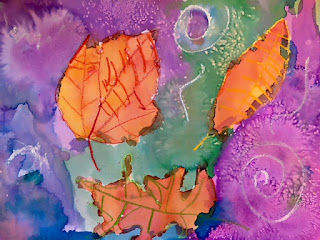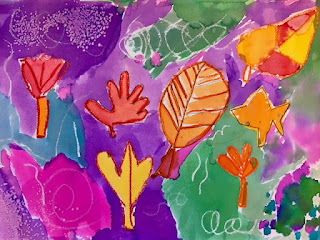3rd grade artists painted pumpkins this fall! We began by exploring the color orange. We recalled that to make orange, a secondary color, you mix red and yellow, which are primary colors. We noticed that there are actually many different kinds of orange. We experimented with what might happen if we added more yellow or more red. We also used white to make tints of orange, and black to make shades of orange. We tried to see how many different kinds of orange we could mix, and painted them on paper.
The following class, we got our orange explorations back and cut out shapes from the colors we created. We discussed the difference between geometric and organic shapes and students cut out both kinds of shapes. We glued them to a larger mural, trying to show the wide variety of orange. We organized the pieces so it went from light to dark.
Now that we knew how to mix many different kinds of orange, we began to paint pumpkins! Students drew a pumpkin that was placed in the middle of their table -- big thanks to Ms. Patashnick, our music teacher, for the pumpkins! Looking carefully at its shape and lines, students drew their pumpkin from observation. We noticed the lines of the pumpkin followed its curved shape, which made our pumpkins look more round.
The following class, students looked at the pumpkins again and noticed that there are lighter areas where the light hits the pumpkin and darker areas that are in shadow. Thinking back to the lighter and darker oranges they had mixed, students painted their pumpkins from observation, noting where it was lighter and darker on their pumpkin. We also mixed greens for the stem.
We also included the shadow that the pumpkin cast on the table. We noticed that it was darkest closest to the pumpkin, and a curved shape similar to the pumpkin. Students mixed a darker color to use for the shadow, and also painted the background so that the pumpkin looked like it was sitting on something. Below are some examples of our painted pumpkins!
 |
| Aaron, 3rd Grade (Monfette) |
 |
| Ellian, 3rd Grade (Monfette) |
 |
| Elizabeth, 3rd Grade (DeBaie & Nickl) |
 |
| Evelyn, 3rd Grade (Fletcher) |
 |
| Finnley, 3rd Grade (Fletcher) |
 |
| Isabel, 3rd Grade (Fletcher) |
 |
| Lily, 3rd Grade (Fletcher) |
 |
| NJ, 3rd Grade (DeBaie & Nickl) |
 |
| Wyatt, 3rd Grade (Donato) |
 |
| Kemi, 3rd Grade (Donato) |
 |
| Noah, 3rd Grade (Donato) |
 |
Willa, 3rd Grade (Donato)
|
































































